Program
Leon Janacek
String Quartet No. 1, “Kreutzer Sonata”
Orlande de Lassus
La nuit froide et sombre
John Dowland
Come, heavy sleep
Felix Mendelssohn
Quartet No. 6 in F minor
Castalian String Quartet
The Castalian String Quartet is taking the international chamber music scene by storm. They have recently been announced as the first Hans Keller String Quartet in Residence at the University of Oxford. Frequent performers at London’s Wigmore Hall, they also perform at major concert halls all over the world such as Carnegie Hall, the Berlin Philharmonie, and the Vienna Konzerthaus.
Castalian String Quartet website
Program Notes
Leoš Janáček (1854-1928)
String Quartet No. 1, “Kreutzer Sonata” (1923).
Performance time: 20’
In 1923, The Arts Club of Chicago hosted the opening of Pablo Picasso’s first United States show; Louis Armstrong made his first recordings in 1923 as a member of the King Oliver Group; Adolf Hitler and his followers staged the Beer Hall Putsch in Munich.
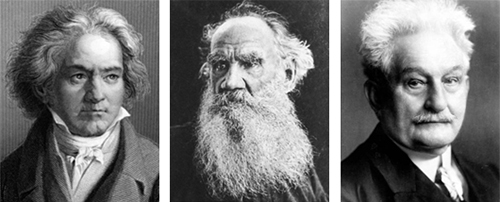
Ludwig von Beethoven Leo Tolstoy Leoš Janáček
German (1770-1827) Russian (1828-1910) Czech (1854-1928)
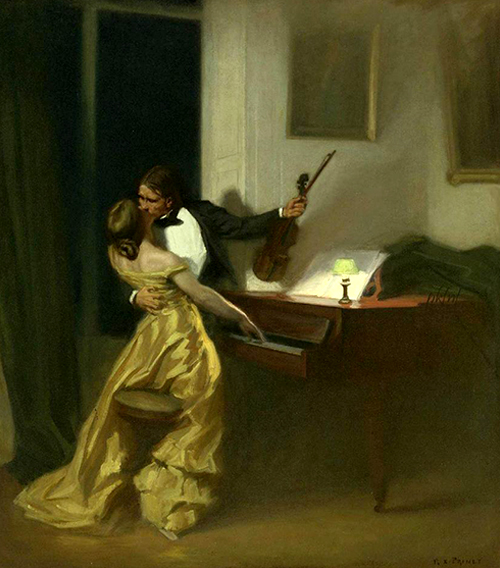
The Kreutzer Sonata, painting by René-Xavier Prinet (1901). 46”x41.”
Now in Museo Revoltella, Trieste, Italy
“Kreutzer Sonata”: this title evokes the image of four nesting Russian dolls, each one inside yet another. At the very center is Beethoven’s 1803 piano and violin sonata (Op. 47, no. 9) dedicated to violinist Rodolphe Kreutzer (both German). This sonata is known for its many emotions: intense anger, deep meditation, and extreme happiness. The next enveloping doll is the Russian Leo Tolstoy’s 1889 novella of that title, which depicts the murder of a wife by her husband who suspects her of being unfaithful with her violinist partner. At an important point in the novella, the pair perform the Beethoven sonata at a social occasion. The third enveloping doll is the Kreutzer Sonata painting from 1901 by French painter René-Xavier Prinet, depicting the musicians in a passionate if illicit embrace. And the final, outermost doll is our work today, beloved Czech composer Leoš Janáček’s 1923 string quartet which he titled “Kreutzer Sonata.” This theme crosses national boundaries, eras and artistic genres.
Janáček drew inspiration from both Beethoven and Tolstoy. He himself late in life had fallen madly in love with a much younger married woman, Kamila Stosslova, and she became his musical muse. He wrote to her daily, describing her impact on his music. He wrote, "I was imagining a poor woman, tormented and run down, just like the one the Russian writer Tolstoy describes in his “Kreutzer Sonata". In the third movement, Janáček presents a direct quote from the Beethoven sonata, used as a duet between the first violin and the cello, with caustic interruptions by the second violin and viola. He uses neither traditional formal musical structure nor programmatic content in this composition. So, as some have said, this is “expressionistic” music, and it remains “inscrutable”. One can listen for how the melody, changing rhythms, dynamics and color are used to evoke and describe ecstasy, rage, despair, jealousy and desire. One is truly left breathless at the end.
Please be sure to check the embedded links (above in blue) for the very special performance by Nathan Milstein of the Beethoven sonata and to the complete text of the Tolstoy novella. Here is a performance of the Janáček quartet performed by the Vermeer Quartet, the internationally famed quartet in residence at Northern Illinois University for 37 years.
Orlande de Lassus (1532-1594)
“La nuit froide et sombre.” Poet: Joachim du Bellay (c.1522-1560).
Performance time: 3’
John Dowland (1563-1626)
“Come heavy sleep.” Poem: anonymous.
Performance time: 4’
In late 16th century Renaissance, Breugel depicted Flemish peasants in 1560’s; Michelangelo died in Rome in 1564 Elizabeth I, Queen of England (1558-1603), defeated Philip II’s Spanish Armada in 1588.

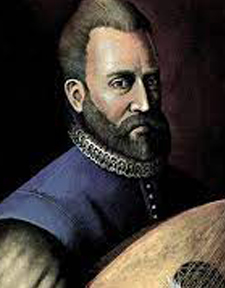
Orlande de Lassus (1532-1594) John Dowland (1563-1626)
The composers Orlande de Lassus (Flemish—his name is spelled variously) and John Dowland (English) were two of the most celebrated songwriters of the late Renaissance. De Lassus took this text by his contemporary, French poet and critic Joachim du Bellay, and set it for vocal ensemble a cappella (no instruments). Dowland set an anonymous text for solo voice and lute (early guitar-like instrument). Today we hear both songs as transcribed for string quartet, without voices. Since it is helpful to understand whence comes the emotional content of the music, here are the texts:
De Lassus, “La nuit froide et sombre"
|
La nuit froide et sombre |
Cold, dark night |
|
Puis le jour [luisant] |
Then the lightening day, |
Dowland, “Come, Heavy Sleep”
Come, heavy Sleep, the image of true Death,
And close up these my weary weeping eyes,
Whose spring of tears doth stop my vital breath,
And tears my heart with Sorrow’s sigh-swoll’n cries.
Come and possess my tired thought-worn soul,
That living dies till thou on me be stole.
Come, shape of rest, and shadow of my end,
Allied to Death, child to his joyless black-fac’d Night,
Come thou and charm these rebels in my breast,
Whose waking fancies doth my mind affright.
O come, sweet Sleep, or I die forever;
Come ere my last sleep comes, or come thou never.
Here are lovely performances of both works as originally set, first de Lassus and then Dowland.
Felix Mendelssohn (1809-1847)
Quartet No. 6 in F minor, Op. 80 (1847).
Performance time: 27’
In 1847, Verdi’s “Macbeth” premiered; the Brontë sisters Charlotte, Emily and Anne published Jane Eyre, Wuthering Heights, and Agnes Grey, respectively; Brigham Young and followers arrived in Great Salt Lake Valley, Utah.
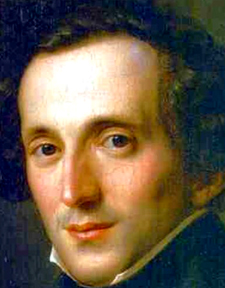
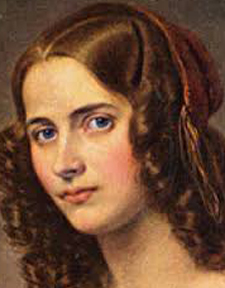
Felix Mendelssohn (1809-1847) Fanny Mendelssohn (1805-1847)
This quartet is Mendelssohn’s last completed piece of chamber music. It is his most powerful, passionate and angry chamber work, composed upon the unexpected death by stroke of his beloved sister Fanny (aged 41). Felix collapsed at the terrible news and was even unable to attend her funeral. He then went to Interlaken, Switzerland for the summer and wrote this quartet. Felix subtitled it “Requiem for Fanny,” but it may be considered his own requiem as he himself died from a stroke, just two months after completing it. Indeed, both their parents and grandfather Moses had died from strokes.
The quartet’s first movement features a strong, rhythmic, intense statement of its main theme which ascends both in pitch and in volume, interrupted by a brief quiet respite, but then quickly followed by a continuation of the driving first theme. Unlike Mendelssohn’s other scherzos which are light and effervescent, this second movement is “savage and sardonic.” The highly syncopated, even dissonant statements of the theme are angry and tense. The third movement, a poignant, passionate, song, shows the other side of Mendelssohn’s anguish here. The powerful climax is followed by a quiet resolution. Then the Finale, written in traditional sonata form, moves its two themes through each of the four instruments, over tremolo passagework in the supporting voices, intensifying the composer’s expression of his anguish. The movement concludes with a high-register restatement of the theme by the first violin at highest volume.
Here is a ChamberFest Cleveland performance by a quartet whose two violinists, Alexi Kenney and Nathan Meltzer, are both winners of the Concert Artists Guild competition, the organization which I am proud to chair here in New York.
—Program Notes by Louise K. Smith
Thanks to Melvin Berger, Nancy Monsman, Kai Christiansen and Lucy Miller Murray.
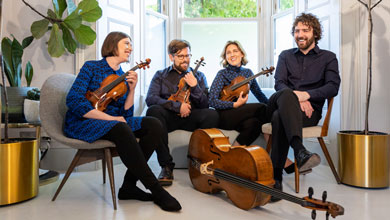
Castalian String Quartet
Subscribe
Today!
Individual tickets may be purchased at the door (cash or check only) immediately before each concert.
All concerts are held at a private club just off Michigan Avenue in Chicago.
Call or email Tricia Fusilero for more information
773-823-5569 x1012
office@ChicagoChamberMusicSociety.org